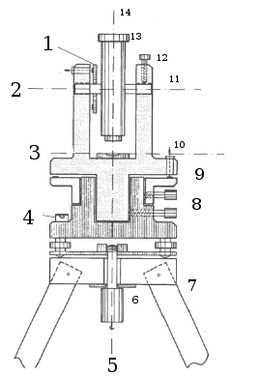Theodolite
| sorry: |
This section is still under construction! This article was last modified on 05/14/2011. If you have comments please use the Discussion page or contribute to the article! |
Functional principle
A theodolite is used for measuring vertical and horizontal angels. The main parts are the horizontal and the vertical circles, which are scaled in gon. It is regularly placed on a tripod and features several spirit levels for adjusting the theodolite in the field.

Measuring polygonal chains
The choice of the points (vertices) of the polygons depend on the aim of the mensuration. In most cases, one will follow the course of roads and trails. The single segments should be located in a way that other objects can be connected easily. The line segments should be relatively long, to keep the error propagation low - not less than 50 meters and, under normal circumstances, not more than 200 to 300 meters.
To asses the absolute position of a polygon chain, it has to be connected to a trigonometric vertex close to it. Generally, close vertices should be part of the polygonal chain.
In the field, the procedure goes as follows: The individual vertices are to be marked with perpendicular ranging rods. The theodolite is centered exactly over the respective vertex. Both tasks are to be fulfilled with full attention to minimize errors in the angle measurement.
From each vertex, the distance to the preceding and to the following vertex is measured. The distance mensuration is done twice, the second measuring can be seen as safety mensuration. The mean of both mensurations is seen as the best approximation of the real distance. The distance is mostly obtained with electronic distance measurement tools. The angle of refraction between two distances can be derived from the difference between the two readings of the horizontal circle obtained by the bearing to the preceding and the following vertex.